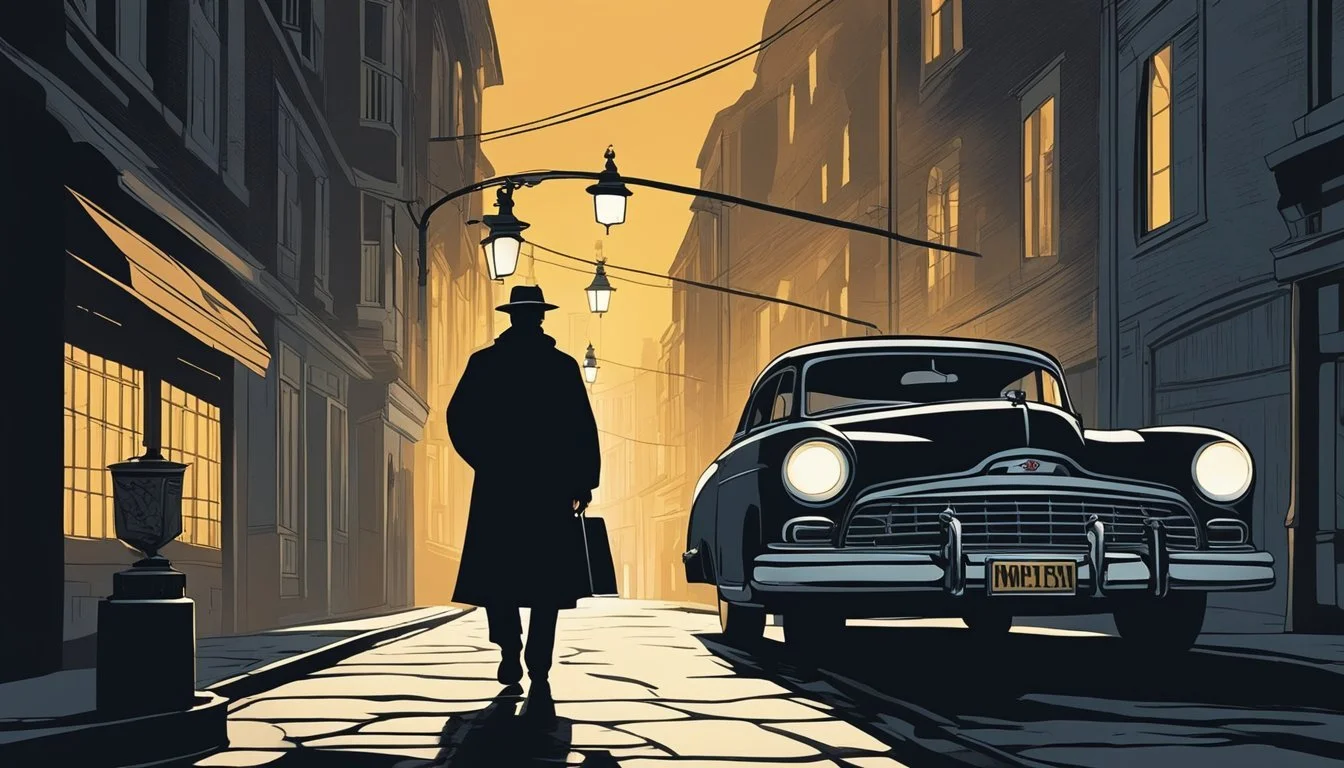I Am the Night
The Black Dahlia Murder's Unexpected Family Connection Reveals New Case Details
"I Am the Night" delves into the haunting mystery of the Black Dahlia murder through an unexpected family connection. The limited television series, created by Sam Sheridan, explores the true story of Fauna Hodel, an adopted teenager who uncovers her link to one of America's most infamous unsolved crimes.
Fauna Hodel's journey of self-discovery leads her to her grandfather, George Hodel, a renowned physician and suspect in the Black Dahlia case. Set in 1965, the show blends fact and fiction to portray Fauna's investigation into her own origins and the dark secrets of her family history. While some elements are dramatized for television, the core of Fauna's story and her connection to the Black Dahlia murder are rooted in reality.
The series creators, Patty Jenkins and Sam Sheridan, knew Fauna Hodel personally before her death in 2017. This relationship adds depth and authenticity to the portrayal of Fauna's experiences. Though the character of Jay Singletary, played by Chris Pine, is a fictional composite, his inclusion serves to highlight the ongoing fascination and investigation surrounding the Black Dahlia murder case.
Elizabeth Short's Murder and the Black Dahlia Case
The brutal murder of Elizabeth Short in 1947 Los Angeles remains one of the most infamous unsolved crimes in American history. Known as the Black Dahlia case, it captivated public attention and continues to intrigue true crime enthusiasts decades later.
The Unsolved Murder of 1947
On January 15, 1947, a passerby discovered Elizabeth Short's mutilated body in Leimert Park, Los Angeles. The 22-year-old aspiring actress had been severed at the waist and drained of blood. Her face was slashed into a gruesome smile.
The LAPD launched an extensive investigation, interviewing hundreds of suspects. The press dubbed Short the "Black Dahlia," linking her to a recent noir film. Despite intense public interest, the case went cold.
Short's murder became synonymous with the dark underbelly of Hollywood dreams. It inspired countless books, films, and theories about her killer's identity.
Dr. George Hodel and the LAPD Investigation
Years after the initial investigation, former LAPD detective Steve Hodel proposed his own father, Dr. George Hodel, as a prime suspect. George Hodel was a prominent Los Angeles physician with alleged ties to Hollywood's elite.
Steve Hodel claimed his father possessed surgical skills matching the precision of Short's wounds. He also pointed to George's art collection, which included surrealist works reminiscent of the crime scene.
The LAPD never officially named George Hodel as a suspect. However, declassified files revealed he was under surveillance in 1950. The case remains unsolved, fueling ongoing speculation and research into Los Angeles' noir-tinged past.
I Am the Night - The Television Series
"I Am the Night" brings the Black Dahlia case to life on screen, blending fact and fiction in a gripping narrative. The series explores the Hodel family's connection to one of Los Angeles' most infamous unsolved murders.
The Plot of 'I Am the Night'
Set in 1965, the series follows Fauna Hodel, a teenage girl searching for her true identity. As she uncovers her family history, Fauna becomes entangled in the dark legacy of her grandfather, Dr. George Hodel. The story intertwines with Jay Singletary, a disgraced journalist portrayed by Chris Pine.
Fauna's journey leads her to Los Angeles, where she encounters a web of secrets and lies. The narrative skillfully weaves together elements of the Black Dahlia murder case, family drama, and personal discovery.
Adaptation and Screen Representation
"I Am the Night" was created by Sam Sheridan and directed by Patty Jenkins, known for her work on "Wonder Woman." The limited series aired on TNT in 2019, consisting of six episodes.
The show's creators had a personal connection to the story. They knew the real Fauna Hodel, who passed away in 2017. This relationship influenced their approach to adapting her story for television.
Jenkins and Sheridan aimed to balance historical accuracy with dramatic storytelling. They incorporated noir elements and period details to recreate 1960s Los Angeles. The series received praise for its atmospheric visuals and strong performances, particularly from Chris Pine and India Eisley as Fauna.
Fauna Hodel's Journey
Fauna Hodel's life was shaped by secrets, identity struggles, and a quest for truth. Her journey from a young girl with mysterious origins to a woman uncovering her family's dark past captivated audiences and inspired adaptations.
From 'One Day She'll Darken' to Discovering her Past
Fauna Hodel's memoir "One Day She'll Darken" chronicled her remarkable journey of self-discovery. Born to a white teenage mother and given up for adoption, Fauna was raised in a black family. Her birth certificate listed her as "Negro," despite her fair skin.
As she grew older, Fauna began questioning her background. Driven by curiosity, she embarked on a quest to uncover her true origins. This search led her to unravel a complex family history intertwined with the infamous Black Dahlia murder case.
Fauna's investigation revealed her biological grandfather was Dr. George Hodel, a prominent Los Angeles gynecologist and suspect in the unsolved Black Dahlia murder. This shocking discovery connected her personal story to one of America's most notorious crimes.
Bi-Racial Identity and Social Challenges
Fauna's biracial identity posed unique challenges throughout her life. Raised in a black family but visibly white, she struggled to find her place in a racially divided society.
Her experiences with poverty and discrimination shaped her worldview. Fauna navigated complex social dynamics, often feeling like an outsider in both black and white communities.
These struggles informed her later advocacy work. Fauna became a voice for mixed-race individuals, sharing her story to promote understanding and acceptance.
India Eisley portrayed Fauna in the TV series "I Am the Night," bringing her journey to a wider audience. The show highlighted Fauna's resilience in the face of adversity and her determination to uncover the truth about her family.
Investigative Breakthroughs and Steve Hodel's Contributions
Steve Hodel's research into the Black Dahlia case brought forth new evidence and accusations. His work also shed light on George Hodel's past, including a controversial incest trial.
Steve Hodel's Evidence and Accusations
Steve Hodel, a former LAPD detective, authored the bestselling book "Black Dahlia Avenger." In it, he presented evidence suggesting his father, Dr. George Hodel, was responsible for Elizabeth Short's murder.
Hodel's investigation uncovered potential links between his father and other unsolved murders in California, Chicago, and Manila. He claimed George Hodel fled the United States to evade prosecution.
The evidence included photographs, handwriting analysis, and witness testimonies. Steve Hodel's work sparked renewed interest in the decades-old case.
Revisiting George Hodel's Incest Trial
In the 1940s, George Hodel faced accusations of sexual abuse from his daughter, Tamar Hodel. This led to a highly publicized incest trial.
The trial exposed dark secrets within the Hodel family. Despite the serious nature of the charges, George Hodel was acquitted.
Steve Hodel's research revisited this trial, connecting it to the broader pattern of his father's alleged crimes. He argued that the incest case provided insight into George Hodel's character and behavior.
The trial's records and testimonies became crucial pieces in Steve Hodel's investigation of the Black Dahlia murder.
Cultural and Historical Context
Los Angeles in the 1940s and 1960s was a city of stark contrasts, where glamour and darkness intertwined. The Hodel family's involvement in Hollywood's underbelly exposed a sinister side of the entertainment capital.
Los Angeles in the 1940s and 1960s
In 1947, Los Angeles was a booming metropolis, attracting dreamers and opportunists. The film industry flourished, creating a facade of glitz and glamour. However, beneath the surface lurked corruption and crime.
By 1965, the city had evolved, but its dark undercurrents persisted. The Black Dahlia murder of 1947 still haunted the collective memory, exemplifying the noir atmosphere that permeated the era.
Los Angeles' rapid growth led to increased racial tensions and social inequalities. These issues formed the backdrop for many noir films, reflecting the city's complex reality.
The Hodel Family and Hollywood's Dark Side
The Hodel family's connection to Hollywood exposed a web of secrets and scandals. Dr. George Hodel, a prominent physician, moved in elite circles while allegedly harboring dark secrets.
His involvement in the Black Dahlia case highlighted the intertwining of high society and criminal elements. The family's story became a microcosm of Hollywood's hidden depravities.
Tamar Hodel's experiences, including giving birth at 16, shed light on the exploitation of young women in the entertainment industry. The Hodel saga revealed how power and influence could shield potential wrongdoers from justice.
Aftermath and Legacy
The Black Dahlia murder case continues to captivate public interest decades after the crime. Its enduring mystery has spawned numerous theories, books, and adaptations, leaving an indelible mark on true crime culture.
The Continued Interest in the Black Dahlia Murder
The gruesome nature of Elizabeth Short's murder and the failure to identify her killer have fueled ongoing fascination. Books, films, and TV shows regularly revisit the case, offering new perspectives and theories. Amateur sleuths and professional investigators alike continue to pore over evidence, hoping to crack the cold case. The Black Dahlia murder has become a symbol of Hollywood's dark underbelly, intertwining with the city's noir mystique.
Unsolved Murders and True Crime Stories
The Black Dahlia case inspired a wave of true crime storytelling. It remains one of the most famous unsolved murders in American history. The case highlights the challenges faced by law enforcement in solving complex crimes. Many other unsolved murders have since been compared to the Black Dahlia, creating a subgenre of cold case stories. True crime enthusiasts often cite the Black Dahlia as a gateway into their interest in unsolved mysteries. The case continues to influence how media portrays and public perceives unsolved crimes.
Family Secrets and Discoveries
Fauna Hodel's search for her true identity unveiled shocking revelations about her family's dark past. Her journey exposed connections to one of America's most infamous unsolved crimes.
Tamar Hodel's Revelations and Family Impact
Tamar Hodel, Fauna's biological mother, was at the center of disturbing family secrets. At age 14, Tamar accused her father, Dr. George Hodel, of sexual assault. This allegation led to a highly publicized 1949 incest trial, which ended in George's acquittal.
Pregnant at 16, Tamar gave birth to Fauna in 1951. She gave the baby up for adoption to Jimmie Lee Greenwade, a black woman in Reno, Nevada. Fauna grew up believing she was biracial and struggled with her identity.
Years later, Tamar revealed her suspicions about her father's involvement in the Black Dahlia murder. These claims were explored in the podcast "Root of Evil," which delved into the Hodel family history.
The revelations had a profound impact on the family. Fauna's discovery of her true heritage led her to reconnect with her biological relatives. This journey exposed the complex web of secrets and trauma that had shaped her family for generations.





